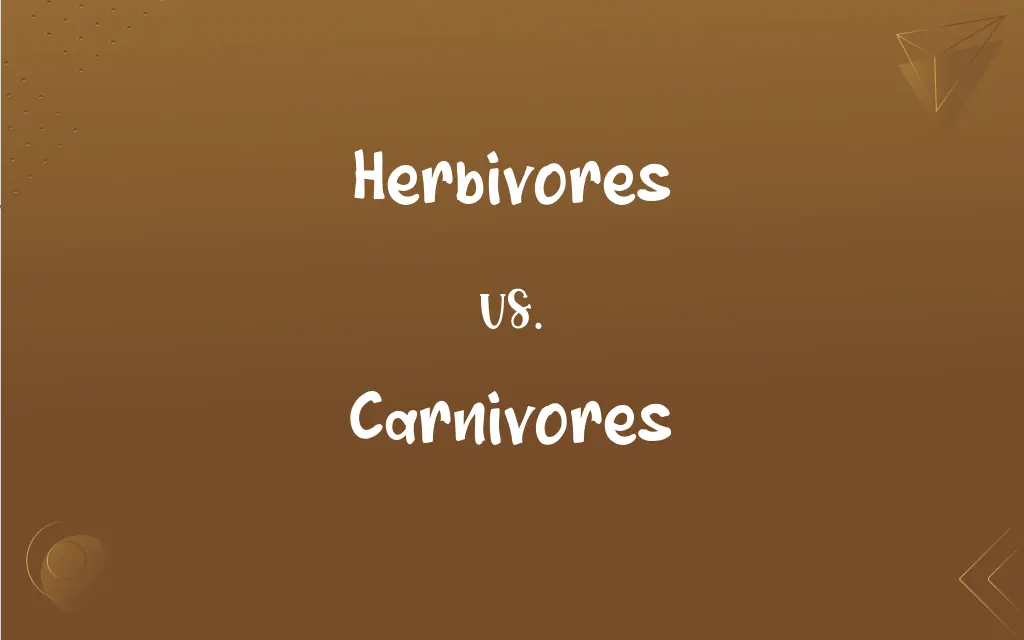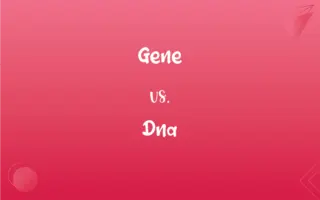Herbivores vs. Carnivores: What's the Difference?
Edited by Aimie Carlson || By Harlon Moss || Updated on October 27, 2023
Herbivores eat plants; carnivores consume meat.

Key Differences
Herbivores exclusively eat plant material. Carnivores consume flesh from other animals.
The digestive system of herbivores is adapted for plant digestion. Carnivores have digestive systems optimized for meat processing.
Herbivores have flat, grinding teeth. Carnivores possess sharp, tearing teeth.
Herbivores often have a longer digestive tract. Carnivores typically have a shorter digestive tract.
Herbivores play a role in controlling plant growth. Carnivores help regulate animal populations.
ADVERTISEMENT
Comparison Chart
Diet
Eat plants
Eat meat
Digestive System
Adapted for plant digestion
Optimized for meat processing
Teeth
Flat, grinding teeth
Sharp, tearing teeth
Digestive Tract
Longer
Shorter
Ecological Role
Control plant growth
Regulate animal populations
ADVERTISEMENT
Eating Behavior
Mostly grazing or browsing
Hunting or scavenging
Energy Source
Directly from plants
From animal protein
Vision
Often have wide-angle vision
Usually have forward-facing vision
Stomach Type
Many have multi-chambered stomachs
Single-chambered stomach
Behavior
Often herd animals
Many are solitary hunters
Herbivores and Carnivores Definitions
Herbivores
Organisms that consume plant-based diets.
Giraffes are herbivores that eat leaves from tall trees.
Carnivores
Animals that eat other animals.
Lions, as carnivores, hunt and consume prey.
Herbivores
Animals that eat only plants.
Cows, as herbivores, graze on grass.
Carnivores
Animals adapted for consuming animal flesh.
Eagles, adept carnivores, snatch fish from the water.
Herbivores
Animals adapted to digest plant material.
As herbivores, rabbits have specialized teeth for grinding vegetation.
Carnivores
Meat-eating animals.
Wolves, as carnivores, have a diet consisting primarily of meat.
Herbivores
Creatures whose food source is flora.
Deer, herbivores by nature, browse on shrubs and grasses.
Carnivores
Creatures whose food source is other animals.
As carnivores, crocodiles prey on a variety of aquatic and land animals.
Herbivores
Plant-eating animals.
The herbivores in the savannah include zebras and elephants.
Carnivores
Organisms that feed on meat.
The carnivores of the ocean, like sharks, are formidable predators.
Herbivores
An animal that feeds chiefly on plants.
Carnivores
Any of various mammals of the order Carnivora, including the dogs, cats, bears, weasels, raccoons, and seals, most of which are predatory flesh-eating animals.
Herbivores
Plural of herbivore
Carnivores
Any of various other flesh-eating animals.
Carnivores
An insectivorous plant.
Carnivores
Plural of carnivore
FAQs
Do carnivores eat plants?
Primarily, no. They're adapted for a meat-based diet.
What do herbivores eat?
They eat plants and vegetation.
What do carnivores eat?
They consume meat from other animals.
Can herbivores digest meat?
Generally, no. Their digestive systems are not suited for it.
What kind of teeth do herbivores have?
They have flat, grinding teeth.
Are all herbivores peaceful?
Not necessarily, but they don't hunt for prey.
Are all carnivores aggressive?
They can be aggressive while hunting, but not all are inherently aggressive.
How do herbivores impact the ecosystem?
They control plant growth and provide energy for carnivores.
What kind of teeth do carnivores have?
They possess sharp, tearing teeth.
Why do carnivores have sharp claws?
For capturing and tearing their prey.
Can herbivores be predators?
No, they don't prey on other animals.
Do herbivores have a complex stomach?
Many do, like ruminants with multi-chambered stomachs.
What's the digestive tract of carnivores like?
It's usually shorter and simpler.
Are all big cats carnivores?
Yes, they are meat-eating predators.
What role do carnivores play in nature?
They regulate animal populations and maintain ecological balance.
Can animals be both herbivores and carnivores?
No, but some are omnivores, eating both plants and meat.
Do herbivores have a special adaptation for their diet?
Yes, like specialized teeth and digestive systems.
Are herbivores important for biodiversity?
Yes, they play a crucial role in maintaining diverse ecosystems.
Can carnivores be prey?
Yes, they can be prey to larger carnivores or humans.
Are there herbivorous birds?
Yes, like parrots and some pigeons.
About Author
Written by
Harlon MossHarlon is a seasoned quality moderator and accomplished content writer for Difference Wiki. An alumnus of the prestigious University of California, he earned his degree in Computer Science. Leveraging his academic background, Harlon brings a meticulous and informed perspective to his work, ensuring content accuracy and excellence.
Edited by
Aimie CarlsonAimie Carlson, holding a master's degree in English literature, is a fervent English language enthusiast. She lends her writing talents to Difference Wiki, a prominent website that specializes in comparisons, offering readers insightful analyses that both captivate and inform.































































